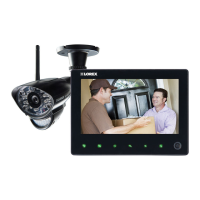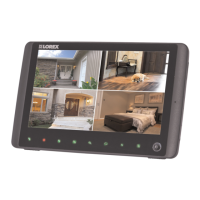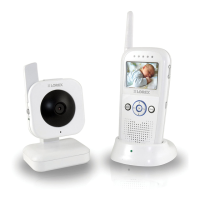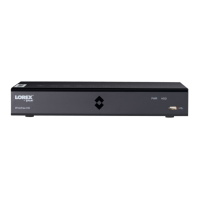Do you have a question about the Lorex LW2730 Series and is the answer not in the manual?
Important warnings regarding electrical shock, fire hazards, and safe product operation.
Provides online and phone contact methods for product assistance and inquiries.
Recommends professional installation, reading guides, and product registration.
Essential safety guidelines for operating and maintaining the system.
Instructions for safe installation, including power sources and cord protection.
Procedures for servicing and using approved replacement parts for safety.
Instructions for cleaning, handling, and using the product safely.
Compliance statements regarding radio frequency emissions and interference.
Information on hazardous substance restrictions and device modification warnings.
Lists main functionalities like display, recording, audio, and connectivity.
Lists and illustrates the included components of the monitoring system.
Provides advice on camera placement and step-by-step mounting instructions.
Guides on installing the antenna, powering the receiver, and inserting the SD card.
Details each part of the camera, including lens, sensors, and audio components.
Explains the purpose and operation of each button on the receiver's front panel.
Details the various ports and connections available on the back of the receiver.
Explains the meaning of different LED lights on the receiver for status monitoring.
Describes the various icons and information displayed on the live view screen.
Instructions on how to access and use the system's menu interface.
Explains how to use and switch between Auto Sequence and Quad viewing modes.
How to zoom in on camera feeds for a closer view during live monitoring.
Instructions for using the intercom feature for two-way audio communication.
How to control the volume for the intercom feature on the receiver.
Steps to connect the system to a TV for larger screen viewing.
Guide on setting the correct date and time for accurate recording and scheduling.
Details the need for an SD card and minimum recording times based on capacity.
Overview of Manual, Schedule, and Motion recording modes and their operations.
Instructions for manually starting and stopping video recording.
How to set a weekly schedule for automatic recording based on time.
Steps for stopping schedule recording and guidelines on when to use it.
How to enable motion detection and select viewing modes for recording.
Setting the length of time recording continues after motion is detected.
Choosing between single channel or 4-channel recording during motion events.
Adjusting sensitivity and settings for video motion detection.
How to select between high and low recording quality for video files.
Managing SD card space by overwriting old files when the card is full.
Steps to view recorded video files directly on the system.
How to navigate, pause, play, and stop recorded videos.
Viewing recorded videos with a smaller camera feed displayed simultaneously.
Viewing uploaded image files stored on the SD card.
How to remove recorded files from the SD card.
Instructions for viewing recorded videos on a computer via SD card.
Instructions for viewing recorded videos on a Mac computer via SD card.
Guide to transferring personal photos to the receiver for use as a digital frame.
Steps to set up blank screen or photo frame modes and transition effects.
How to activate screen saver modes and combine them with motion recording.
Step-by-step guide for pairing new wireless cameras with the receiver.
Adjusting system time, date, and TV output format (NTSC/PAL).
Instructions for formatting the SD card, erasing all data for optimal performance.
Guide on resetting the system to its original factory default configuration.
How to show or hide specific camera channels on the main display.
Steps to individually adjust the brightness for each camera feed.
Details necessary hardware, software, and connection types for remote viewing.
Step-by-step guide for installing drivers and connecting the system to Skype on a PC.
Step-by-step guide for installing drivers and connecting the system to Skype on a Mac.
Instructions for creating new Skype accounts for personal use and the camera.
Information needed for personal and camera Skype accounts.
How to manually switch the displayed camera feed when viewing remotely.
Overview of mobile device compatibility for remote viewing.
Instructions for setting up remote viewing on an iPhone using Skype.
Instructions for setting up remote viewing on an iPad using Skype.
Instructions for setting up remote viewing on Android phones/tablets using Skype.
Details on transmission, frequency, range, and operating conditions.
Technical details for the camera, including sensor, resolution, and night vision.
Technical details for the receiver, including display, resolution, and power.
Importance of unobstructed path between camera and receiver for optimal signal.
Information on how physical barriers can limit wireless transmission range.
Methods and accessories to improve the wireless signal strength and range.
Solutions for issues like no picture, choppy video, or white/distorted images.
Troubleshooting steps for error messages and inability to access menus.
How to install necessary USB drivers for remote viewing via Skype.
Guidance on configuring Skype for remote camera access.
Steps to set the Lorex monitor as the primary webcam in Skype applications.
How to manually select which camera feed is displayed during Skype remote viewing.
Information on available antennas to boost wireless signal strength.
Details on signal security (FHSS) and maximum transmission distances.
Important warnings regarding electrical shock, fire hazards, and safe product operation.
Provides online and phone contact methods for product assistance and inquiries.
Recommends professional installation, reading guides, and product registration.
Essential safety guidelines for operating and maintaining the system.
Instructions for safe installation, including power sources and cord protection.
Procedures for servicing and using approved replacement parts for safety.
Instructions for cleaning, handling, and using the product safely.
Compliance statements regarding radio frequency emissions and interference.
Information on hazardous substance restrictions and device modification warnings.
Lists main functionalities like display, recording, audio, and connectivity.
Lists and illustrates the included components of the monitoring system.
Provides advice on camera placement and step-by-step mounting instructions.
Guides on installing the antenna, powering the receiver, and inserting the SD card.
Details each part of the camera, including lens, sensors, and audio components.
Explains the purpose and operation of each button on the receiver's front panel.
Details the various ports and connections available on the back of the receiver.
Explains the meaning of different LED lights on the receiver for status monitoring.
Describes the various icons and information displayed on the live view screen.
Instructions on how to access and use the system's menu interface.
Explains how to use and switch between Auto Sequence and Quad viewing modes.
How to zoom in on camera feeds for a closer view during live monitoring.
Instructions for using the intercom feature for two-way audio communication.
How to control the volume for the intercom feature on the receiver.
Steps to connect the system to a TV for larger screen viewing.
Guide on setting the correct date and time for accurate recording and scheduling.
Details the need for an SD card and minimum recording times based on capacity.
Overview of Manual, Schedule, and Motion recording modes and their operations.
Instructions for manually starting and stopping video recording.
How to set a weekly schedule for automatic recording based on time.
Steps for stopping schedule recording and guidelines on when to use it.
How to enable motion detection and select viewing modes for recording.
Setting the length of time recording continues after motion is detected.
Choosing between single channel or 4-channel recording during motion events.
Adjusting sensitivity and settings for video motion detection.
How to select between high and low recording quality for video files.
Managing SD card space by overwriting old files when the card is full.
Steps to view recorded video files directly on the system.
How to navigate, pause, play, and stop recorded videos.
Viewing recorded videos with a smaller camera feed displayed simultaneously.
Viewing uploaded image files stored on the SD card.
How to remove recorded files from the SD card.
Instructions for viewing recorded videos on a computer via SD card.
Instructions for viewing recorded videos on a Mac computer via SD card.
Guide to transferring personal photos to the receiver for use as a digital frame.
Steps to set up blank screen or photo frame modes and transition effects.
How to activate screen saver modes and combine them with motion recording.
Step-by-step guide for pairing new wireless cameras with the receiver.
Adjusting system time, date, and TV output format (NTSC/PAL).
Instructions for formatting the SD card, erasing all data for optimal performance.
Guide on resetting the system to its original factory default configuration.
How to show or hide specific camera channels on the main display.
Steps to individually adjust the brightness for each camera feed.
Details necessary hardware, software, and connection types for remote viewing.
Step-by-step guide for installing drivers and connecting the system to Skype on a PC.
Step-by-step guide for installing drivers and connecting the system to Skype on a Mac.
Instructions for creating new Skype accounts for personal use and the camera.
Information needed for personal and camera Skype accounts.
How to manually switch the displayed camera feed when viewing remotely.
Overview of mobile device compatibility for remote viewing.
Instructions for setting up remote viewing on an iPhone using Skype.
Instructions for setting up remote viewing on an iPad using Skype.
Instructions for setting up remote viewing on Android phones/tablets using Skype.
Details on transmission, frequency, range, and operating conditions.
Technical details for the camera, including sensor, resolution, and night vision.
Technical details for the receiver, including display, resolution, and power.
Importance of unobstructed path between camera and receiver for optimal signal.
Information on how physical barriers can limit wireless transmission range.
Methods and accessories to improve the wireless signal strength and range.
Solutions for issues like no picture, choppy video, or white/distorted images.
Troubleshooting steps for error messages and inability to access menus.
How to install necessary USB drivers for remote viewing via Skype.
Guidance on configuring Skype for remote camera access.
Steps to set the Lorex monitor as the primary webcam in Skype applications.
How to manually select which camera feed is displayed during Skype remote viewing.
Information on available antennas to boost wireless signal strength.
Details on signal security (FHSS) and maximum transmission distances.
| Brand | Lorex |
|---|---|
| Model | LW2730 Series |
| Category | Security System |
| Language | English |











